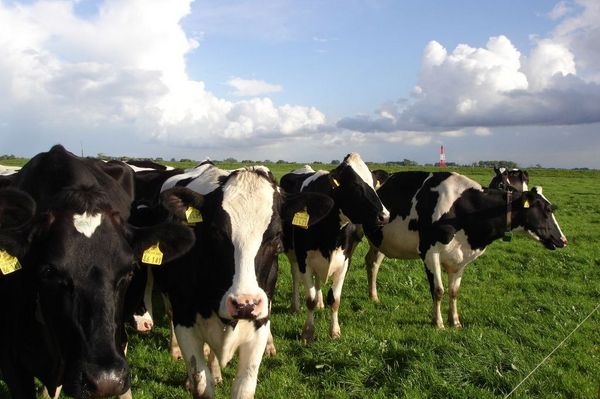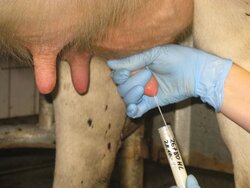Expertise
Organic cattle farming
Kerstin Barth | 01.06.2022
Organic cattle farming is used for the production of both milk and beef. Milk production and cattle fattening can take place separately on specialised farms, but also on the same farm.

The following production directions can be distinguished:
Organic dairy farming focuses on milk production. The female calves are raised on the farm to become dairy cows or sold for breeding. The male calves are sold to fattening farms at an early stage.
In organic cattle fattening, only beef is produced. The animals are usually bought in from other farms.
Organic suckler cow husbandry is also used for meat production. The young animals are raised by their mothers. Their milk is used exclusively for the calves, i.e. the cows are not milked.
In organic cattle farming, the same breeds are usually kept as in conventional farming. Depending on the type of farming, there are breeds with a high milk yield, such as the German Holstein, or dual-purpose breeds such as the German Fleckvieh, which is equally suitable for milk and meat production, or pure meat breeds for meat production.
According to the guidelines for organic farming, the breeds used should be adaptable, vital and resistant to diseases. Breeds or lines for which certain health problems are typical should be avoided; in the case of the White Blue Belgian, for example, births often require a Caesarean section.
In organic farming, animals must be given permanent access to open air areas, preferably pasture. Only in bad weather or unfavourable soil conditions may this be dispensed with. According to the EU Organic Farming Regulation, there is no general obligation to graze in the summer months, but this can be demanded through private law agreements with organic associations, dairies or food retailers.
If the animals have access to pasture in the grazing season and can move freely in winter, i.e. are kept in a loose housing, then the animals do not have to be offered an outdoor run in winter. Small herds may still be kept in tethers. However, they must be allowed to graze in summer and have access to a run at least twice a week in winter.
A special regulation exists for cattle fattening: animals in final fattening may be kept indoors permanently, but this period may not exceed 20 % of the total life of the animals and may not exceed three months.
In the barn, the animals must be provided with a bedded, dry and clean lying area of sufficient size. Areas used as slatted floors must account for less than half of the area of the house. Complete housing on slatted floors, as is common e.g. in conventional cattle fattening, is not permitted in organic farming.
Differences to the conventional system also exist in calf husbandry: while according to the Calf Husbandry Ordinance, which applies to all German cattle farmers, calves may be kept alone for the first seven weeks of their lives, this is only permitted in the first week of life in organic farming. This regulation is intended to take into account the natural behaviour of the animals and to promote their social development. Of course, sick animals may be kept separately if necessary.
In contrast to conventional cattle husbandry, organic farming also has regulations on how much space must be made available to the animals in the barn or run:
| Barn (m2 per animal) | Run (m2 per animal) | |
|---|---|---|
| Cattle up to 100 kg | 1,5 | 1,1 |
| Cattle up to 200 kg | 2,5 | 1,9 |
| Cattle up to 350 kg | 4 | 3 |
| Cattle above 350 kg | 5 | 3,7 |
| Dairy cows | 6 | 4,5 |
| Breeding bulls | 10 | 30 |
Ruminants are able to digest plants that are not suitable for human consumption, e.g. grasses. The large forestomach system of cattle even depends on a sufficient supply of crude fibre. Concentrated feed contains hardly any raw fibre, which is why the use of concentrated feed is restricted in organic farming. A maximum of 40 % of the feed provided (converted to dry matter) may consist of concentrated feed. In order not to offer animals too little energy during the period of highest milk production, this proportion may be increased to 50 % for three months.
The feed for ruminants must be 100 % organically produced and at least 60 % should come from the same farm or have been produced in the region.
Calves are fed on natural milk for at least three months. There are no regulations on how the milk should be offered to the calves. Some organic farms also have the calves suckle directly from the cows.
Sick or injured animals must always be treated immediately. Alternative healing methods are to be preferred as long as they actually have a therapeutic effect. However, this proof has not yet been given for all alternative procedures.
The preventive administration of antibiotics or other synthetic allopathic veterinary medicines is always prohibited. Diseases should be prevented with animal-friendly husbandry and care, the choice of suitable breeds and hygiene measures.
If, despite this, medicines have to be used, the prescribed waiting period between the last administration of the medicine and the delivery of the product is twice as long as indicated on the medicine packaging, so that milk or meat can be marketed as "organically produced". If this information is missing, the waiting period is at least 48 hours.
Dairy cows or fattening bulls over one year of age may be treated with synthetic allopathic medicines a maximum of three times per year. In veal production, where calves are usually slaughtered at the age of six to eight months, animals may even be treated in this way only once so that their meat can be marketed as "organically produced".
Organic farming aims to minimise interventions on the animal. Instead, greater attention is to be paid to an animal-friendly design of the husbandry environment. For this reason, dehorning or removal of horns and amputation of tails are prohibited in organic cattle farming. However, in the interest of animal health and for safety reasons, these procedures may be authorised on a case-by-case basis upon application - but only with the administration of anaesthetics and/or painkillers.
An alternative to dehorning is the breeding of genetically hornless cattle. This has been common practice in beef cattle farming for some time, but for the dairy cattle breeds corresponding bulls have only been available for a few years. In addition to the still existing uncertainty about the consequences of breeding for genetic hornlessness, it is also feared that in the foreseeable future there will be no more genetically horned breeding animals available, thus also limiting the diversity of breeds.
The "Demeter" association demands the keeping of horned cattle and therefore does not allow the removal of horn systems or the keeping of genetically hornless animals. Some beef cattle breeds are exempt.
Cattle can convert grassland into meat and milk. In the climate debate, however, they do not have a good reputation, because feeding grass produces methane - a very climate-impacting gas. Organic cattle farming is therefore always in the area of tension between climate-friendly food production and low land competition, as concentrated feed from grain competes with food production.
Combining milk and meat production is a suitable approach. This can be done in a number of ways:
- with the use of dual-purpose breeds that at the same time have an appropriate milk yield level with good meat production capacity,
- by selectively mating dairy cows with beef cattle to produce calves for fattening.
- Also, giving more consideration to dairy beef bulls that inherit good muscling would be a way to give more consideration to the male calves currently produced in dairy production. They usually leave the organic farm at the age of two to three weeks and are sold to conventional fattening farms. There is a need for research in the field of animal-friendly, sustainable cattle (pasture) fattening in order to be able to market the male calves, which have been produced elaborately under organic production conditions, as organic meat in the future.
Although organic animal husbandry is strongly oriented towards animal welfare, widespread production diseases such as mastitis, lameness and metabolic disorders can also be observed on many organic dairy farms. Although much has been done in recent years to develop suitable advisory tools (e.g. the testing of stable schools), the sustainable improvement of animal health in organic farming is still a current problem area.
The extent to which breeding and animal-friendly husbandry practices (grazing, mother contact, extended milk supply in rearing) can contribute to an improvement needs to be further investigated.


![[Translate to English:] Calf rearing with cow contact: natural, healthy and feasible](/media/_processed_/2/8/csm_Projekt_KaeKNatGeB_c_Jacqueline_Felix_2ab571e033.jpg)
![[Translate to English:] InnoRind - Cattle Innovation Network – sustainable cattle farming in Germany, considering animal welfare, environmental impacts and social acceptance](/media/_processed_/d/7/csm_Logo_InnoRind_ee68863cfc.jpg)
![[Translate to English:] ÖKoTier](/media/_processed_/1/5/csm_OeKoTier_Logo_farbig_2d6a0cc09c.png)
![[Translate to English:] TransformDairyNet](/media/_processed_/0/a/csm_Felix_KuhKindergarten_e55f9d9fb7.jpg)





